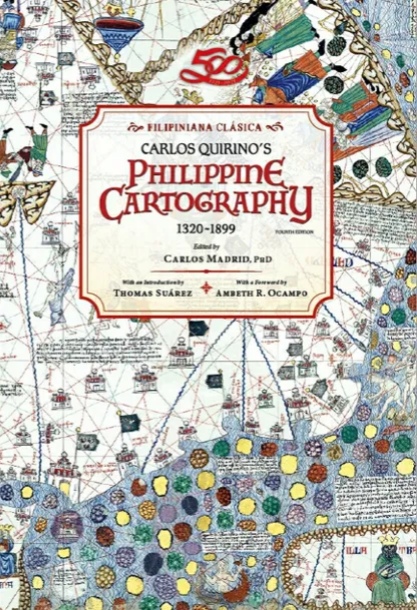Vibal Foundation’s (VF) Philippine Cartography 4th edition won the 2020 Gintong Aklat Awards for Social Sciences category.
The awarding ceremony was streamed live on the Facebook pages of the Book Development Association of the Philippines (BDAP) and Manila International Book Fair (MIBF) on Wednesday afternoon, November 17.
VF’s Program Director Kristine E. Mandigma, book editor Dr. Carlos Madrid, and Ms. Denden Quirino, daughter of the book’s author and National Artist Carlos Quirino, gave their acceptance speeches.
Established in 1871, Gintong Aklat Awards is conferred bi-annually by BDAP.
The outstanding Philippine books are chosen based on overall excellence—from the quality of production, design, and printing to the quality and significance of content.

Philippine Cartography 1320-1899, Fourth Edition
National Artist Carlos Quirino recounts how the concept of the Philippines emerged as a vague grouping of islands in the early fourteenth century and evolved in fits and starts over half a millennium into its current iconography.
The Philippines as a geographical and ideological construct was shaped by a long lineage of cosmographers, cartographers, and artists spanning diverse cultures and times, such as Zhu She Ben, Luo Hong Xian, Abraham Cresques, Francisco Rodrigues, Juan López y Velasco, Diogo Homem, Gerardus Mercator, Sebastian Münster, Robert Dudley, Comte de Lapérouse, Pedro Murillo Velarde, Claudio Montero, Francisco Coello, José Algué, and many others.
From ancient Chinese scrolls, Japanese and Portuguese portolan maps, French scientific surveys, and British merchants’ nautical charts, Quirino weaves a history of heroics and everyday drudgery, of personal and international rivalries, as well as of egregious mistakes and brilliant insights.
Philippine Cartography was first published in a limited edition in 1959 and reissued a second and third time in Amsterdam and Quezon City.
For this fourth edition, editor Dr. Carlos Madrid annotated Quirino’s text and added a selection of over 450 new maps to form the largest bibliography of over 1,600 Philippine cartographic materials.
Profusely illustrated with over 200 images, this edition is further enriched with six remarkable foldout maps, among them the outstanding Topographía de la Ciudad de Manila, which is reproduced for the first time in high resolution.
This edition is also specially honored with a foreword by renowned historian Ambeth Ocampo and an introduction by international author, Thomas Suárez, who presents a meditation on cartography, the making of the Philippines, and the twenty-first century digitality.
Dr. Madrid also appended three significant essays that considerably widen the author’s avenues of inquiry into the Selden map of Southeast Asia, the unheralded Claudio Montero and his Comisión Hidrográfica de Filipinas, and the world-class achievements of Jesuit father Vicente Memije—together with two Filipino artists, Nicolás de la Cruz Bagay and Lorenzo Atlas.
With its erudite text and unparalleled reproduction of rare maps, views, and plans, this book will delight anyone with an interest in antiquity, history, geography, and maps as instruments of power and rare vessels of beauty.
Interested readers may purchase Philippine Cartography and other VFI books at Vibal Online Shop at https://shop.vibalgroup.com, Lazada https://www.lazada.com.ph/shop/vibal-books, and at Shopee https://shopee.ph/vibalgroup.




